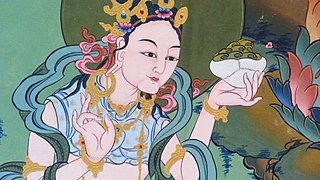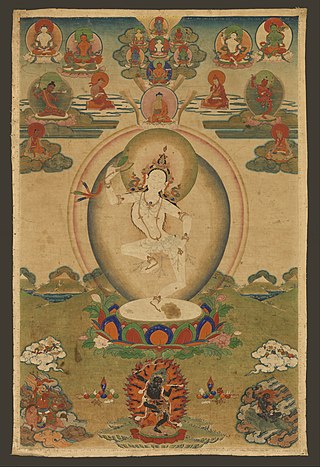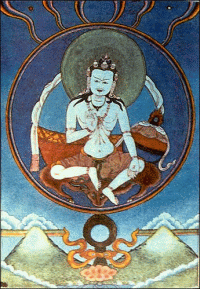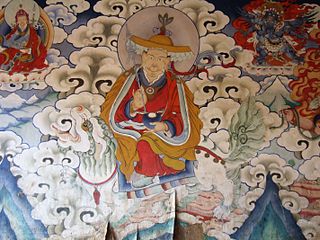
Padmasambhāva, also known as Guru Rinpoche and the Lotus from Oḍḍiyāna, was a tantric Buddhist Vajra master from India who taught Vajrayana in Tibet. According to some early Tibetan sources like the Testament of Ba, he came to Tibet in the 8th century and helped construct Samye Monastery, the first Buddhist monastery in Tibet. However, little is known about the actual historical figure other than his ties to Vajrayana and Indian Buddhism.
A lineage in Buddhism is a line of transmission of the Buddhist teaching that is "theoretically traced back to the Buddha himself." The acknowledgement of the transmission can be oral, or certified in documents. Several branches of Buddhism, including Chan and Tibetan Buddhism maintain records of their historical teachers. These records serve as a validation for the living exponents of the tradition.

Tashi Paljor, Dilgo Khyentse Rinpoche was a Vajrayana master, scholar, poet, teacher, and recognized by Buddhists as one of the greatest realized masters. Head of the Nyingma school of Tibetan Buddhism from 1988 to 1991, he is also considered an eminent proponent of the Rime tradition.

Nyingma, often referred to as Ngangyur, is the oldest of the four major schools of Tibetan Buddhism. The Nyingma school is founded on the first lineages and translations of Buddhist scriptures from Sanskrit into Tibetan in the eighth century, during the reign of King Trisong Detsen.

Jamgön Kongtrül Lodrö Thayé, also known as Jamgön Kongtrül the Great, was a Tibetan Buddhist scholar, poet, artist, physician, tertön and polymath. He was one of the most prominent Tibetan Buddhists of the 19th century and he is credited as one of the founders of the Rimé movement (non-sectarian), compiling what is known as the "Five Great Treasuries". He achieved great renown as a scholar and writer, especially among the Nyingma and Kagyu lineages and composed over 90 volumes of Buddhist writing, including his magnum opus, The Treasury of Knowledge.

Jamyang Khyentse Wangpo, also known by his tertön title, Pema Ösel Dongak Lingpa, was a renowned teacher, scholar and tertön of 19th-century Tibet. He was a leading figure in the Rimé movement.

Yeshe Tsogyal, also known as "Victorious Ocean of Knowledge", "Knowledge Lake Empress", or by her Sanskrit name Jñānasāgara "Knowledge Ocean", or by her clan name "Lady Kharchen", attained enlightenment in her lifetime and is considered the Mother of Tibetan Buddhism. Yeshe Tsogyal is the highest woman in the Nyingma Vajrayana lineage. Some sources say she, as Princess of Karchen, was either a wife or consort of Tri Songdetsen, emperor of Tibet, when she began studying Buddhism with Padmasambhava, who became her main karmamudrā consort. Padmasambhava is a founder-figure of the Nyingma tradition of Tibetan Buddhism, and is considered as a second buddha of our era. She is known to have revealed terma with Padmasambhava and was also the main scribe for these terma. Later, Yeshe Tsogyal also hid many of Padmasambhava's terma on her own, under the instructions of Padmasambhava for future generations.
In Tibetan Buddhism, Ngöndro refers to the preliminary, preparatory or foundational practices or disciplines common to all four schools of Tibetan Buddhism and also to Bon. They precede deity yoga.
Tertön is a term within Tibetan Buddhism meaning a person who is a discoverer of ancient hidden texts or terma. Many tertöns are considered to be incarnations of the twenty five main disciples of Padmasambhava, who foresaw a dark time in Tibet. He and his consort Yeshe Tsogyal hid teachings to be found in the future to benefit beings. A vast system of transmission lineages developed. Scriptures from the Nyingma school were updated by terma discoveries, and terma teachings have guided many Tibetan Bon and Buddhist practitioners.

Ayu Khandro, also known as Dorje Paldrön, was a Tibetan yogini, practitioner and terton of Tantric Buddhism in Eastern Tibet. An accomplished Dzogchen meditator, she is known for her extensive pilgrimages throughout Tibet, long periods of dark retreat practice, the gongter of the practice of the yidam Senge Dongma, various forms of Chöd, and her lifelong dedication to spiritual practice.

Machig Labdrön, or "Singular Mother Torch from Lab", 1055-1149) was a female Tibetan Buddhist monk believed to be a reincarnation of Yeshe Tsogyal, and the renowned 11th-century Tibetan tantric Buddhist master and yogini that originated several Tibetan lineages of the Vajrayana practice of Chöd.
Chöd is a spiritual practice found primarily in the Yundrung Bön tradition as well as in the Nyingma and Kagyu schools of Tibetan Buddhism in Kagyu and Anuyoga in Nyingmapa. Also known as "cutting through the ego," the practices are based on the Prajñāpāramitā or "Perfection of Wisdom" sutras, which expound the "emptiness" concept of Buddhist philosophy.

Garab Dorje was the first human to receive the complete direct transmission teachings of Sutra, Tantra and Dzogchen from Vajrasattva. Garab Dorje then became the teacher of Dzogchen teachings according to Tibetan buddhist and Nyingma school traditions.

Longchen Nyingthig is a terma, revealed scripture, of the Nyingma school of Tibetan Buddhism, which gives a systematic explanation of Dzogchen. It was revealed by Jigme Lingpa (1730–1798).
In Tibetan Buddhism and Bon, Menngagde, is the name of one of three scriptural and lineage divisions within Dzogchen.
Lama Tsultrim Allione is an American author and teacher who has studied in Tibetan Buddhism's Karma Kagyu lineage.

Khenchen Palden Sherab Rinpoche, also known as "Khen Rinpoche," was a teacher, a scholar, a lama, and a Dzogchen master in the Nyingma school of Tibetan Buddhism. He was considered by Penor Rinpoche to be one of the most learned living Nyingma scholars. Palden Sherab founded the Orgyen Samye Chokhor Ling Nunnery, the first nunnery in Deer Park (Sarnath).

Katok Monastery, also transliterated as Kathok or Kathog Monastery, was founded in 1159 and is one of the "Six Mother Monasteries" in Tibet of the Nyingma school of Tibetan Buddhism, built after Samye Monastery. It is located in Payul, Karze Prefecture, Sichuan, China, known as Kham.

Kamalaśīla was an Indian Buddhist of Nalanda Mahavihara who accompanied Śāntarakṣita (725–788) to Tibet at the request of Trisong Detsen. He is considered one of the most important Madhyamaka authors of late Indian Buddhism although little is known about his life aside from details left in Tibetan sources. Tibetan sources refer to him, Santaraksita and Jñānagarbha as rang rgyud shar gsum meaning the “three eastern Svātantrikas” indicating their origins from Eastern India.

Gyalpo spirits are one of the eight classes of haughty gods and spirits in Tibetan mythology and religion. Gyalpo, a word which simply means "king" in the Tibetic languages, in Tibetan mythology is used to refer to the Four Heavenly Kings and especially to a class of spirits, both Buddhist and Bon, who may be either malevolent spirits or oath-bound as dharmapalas.
















